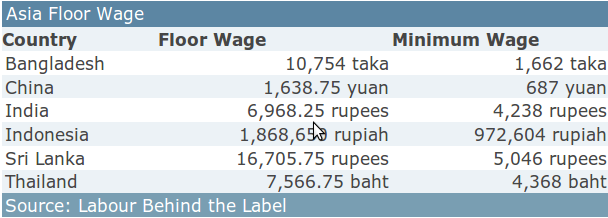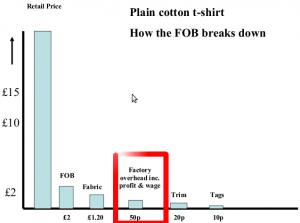 This is the first of a 2-post series looking at issues related to minimum and living wage. This first post scratches the surface of the topic in light of the 2010 wage riots in Bangladesh. The upcoming second post will change geographic area, and look inwards to what is happening in Europe.
This is the first of a 2-post series looking at issues related to minimum and living wage. This first post scratches the surface of the topic in light of the 2010 wage riots in Bangladesh. The upcoming second post will change geographic area, and look inwards to what is happening in Europe.
—
Discussing wages is an interesting thing. On the one hand are those that discuss prices, and in that sense also payments to workers/employees, as mere cost factors. On the other side are those that discuss value-for-money as the going currency, with the final ‘fair’ price only representing what the buyer is willing – instead of able or capable – to pay.
And then there are social phenomena, such as reputation of certain jobs, which make them desirable or not, even in countries where jobs are difficult to get by (and I’m not talking of ‘jobs’ in the water trade). Case in point for this latter aspect: In Sri Lanka, jobs in textile industry are considered “low status jobs” and factories cannot get enough workers even though they offer relatively speaking high salaries, and the national unemployment rate is not negligible.
Businesses that operate on the wages = costs assumption, are – in my opinion – the vast majority of brands and retailers that have gained the textile industry and its out sourcing practises the miserable reputation it boasts in the present. They ‘operate’ the workers in their manufacturing sites just as they would ‘operate’ machines, and the value of a person is reduced to number-of-items-per-hour. It is of little surprise that where at closer analysis the same manufacturers go tight also in any other aspect related to human-rights and international labour rights.
The simplistic bottom line is: Why pay for something if you might get it for free?
(Too) cheap worker salaries is in fact only the sealing nail on the coffin of human and labour rights. In a world were the value of humans is reflected in how much they earn and the power they own, not paying fair wages, or not even paying at all at times, is only the proof of how low the workers doing the particular job are being valued within a cogwheel industry.
But then come the law makers, and Minimum Wage (MW) enters the stage. Technically, MW is "the lowest hourly, daily or monthly remuneration that employers may legally pay to workers. Equivalently, it is the lowest wage at which workers may sell their labour" (Source). Practically one would assume that there is a correlation between a country’s price level for basic commodities and the legally fixed MN. Unfortunately though, the correlation exists only in theory, and in reality more often than not the MN is (sometimes massively) lower than the salary required to even barely subsist. And, needless to say, even then manufacturers try to find loopholes to pay even less than MW (hint: unpaid overtime, children in the workforce, ‘freelancers’, per-piece-contracts etc.). Example needed? This article appeared in the Times on December 6, 2008 and illustrates it clear and dear, while this recent blog post gives a well researched, but slightly biased, summary of the Minimum Wage situation in Bangladesh.
Enter stage Living Wage:= "minimum hourly wage necessary for an individual to meet basic needs, including shelter (housing) and other incidentals such as clothing and nutrition, for an extended period of time or a lifetime"; and its stronger form, Family Wage:= "wage that is sufficient to raise a family on". Both concepts evidently come out of the union tradition and history in Europe and acknowledge that the whole point of working is to be able at at least survive off the money earned. (Truth be told though: not even developed countries have a brilliant record in this aspect. But I’ll leave that for the 2nd instalment of this topic.).
The Family Wage is akin for what has been proposed as a living wage in developing countries in Asia, the Asia Floor Wage (AFL) := Income required for a single earner to minimally support a family of four (adults and 2 children) by working a 48 hour work week. The AFW comprises food costs and non-food costs, with each accounting for half the total wage. Food costs are calculated on the basis of a standard 3,000 calories per day per adult. Non-food costs include healthcare, housing, clothing, childcare, transportation, fuel, education, etc and are calculated as a factor of food costs. The AFL is heavily disputed, notably by organisations equally trying to establish fair wages across entire supply chains, for being ‘too much too soon’ and therefore favouring currently higher (=? fairer) wage countries over those countries at the bottom of the wage pyramid.

Can we actually afford this? And the statement that tends to come right after: The consumers won't pay more!.
Either concern is only half baked. To see this, I don’t even have to go down the path of knitty-grittingly trying to put a monetary value on aspects such as company reputation, (negative) press coverage, ethics, pay-off of sustainable (for the business) long-term business strategies vs. short-term ROE focus,and so on.

In summary, the numbers he comes up with – and which proof that paying fair wages is not only affordable but much less expensive than claimed – look as follows, and make a good business point as to why brands and consumers could well afford fair wage levels:
- A T-shirt costs, before shipping, approximately £2 (~ $2.50).
- Since shipping is done by container, shipping will likely cost anything from near to nothing to about £0.50 per T-shirt.
- Retail prices can vary from £5 to £60 for essentially the same garment.
- Workers as conglomerate of individuals that are part of the production process, receive – if produced in Bangladesh – the equivalent of about £0.50 per T-shirt in average. It hoovers more around the £0.40 level if Bangladeshi old minimum wage is paid, and would be around £0.60 if it were a living wage as requested by the textile workers during the 2010 riots.
To wrap it all up:
Wage represents in the current times more than just payment for work completed. When looking closely, miserable payment conditions often also mean that most other aspect that relate to labour and human-rights will be neglected. Wage hence often is but a symptom of a more serious ‘disease’, which would be greed, not being (and not being held) accountable or responsible. Efforts to implement legal regulations instil grassroots awareness are, and historically always have been at least since the European industrial revolution, a key factor of ensuring some minimum standards.
But it cannot be ignored that were there is abysmal poverty, there will always be people who do the same work for less, and less each time, because anything else would mean dying without trying.
—
This is the first of a 2-post series looking at issues related to minimum and living wage. This first post scratches the surface of the topic in light of the 2010 wage riots in Bangladesh. The upcoming second post will change geographic area, and look inwards to what is happening in Europe.

